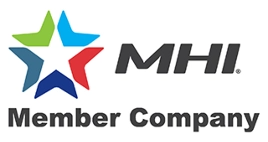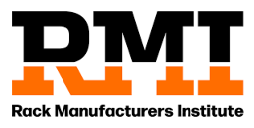October 7, 2022
Minimize Your Bay Width and Aisle Space, Maximize Your Storage Capacity with Raised I-Beam Rack Solutions!
Raised I-Beam Rack Solutions
Every operation strives to have a rack solution that maximizes their warehouse’s storage capacity, which, in turn, will minimize their costs, regarding each of the pallets they store. This rise in storage capacity, along with a decline in costs, is especially critical as operations seek to achieve a positive return-on-investment (ROI) in various scenarios. For example, they’ll especially desire to achieve a fast, high ROI in scenarios like warehouse real estate markets that have limited land availability and premium costs, as well as Refrigerated Warehousing Applications, in which their goods’ storage costs are amplified.
The design of an ideal rack solution, in order to maximize storage capacity, is unique to each application too – and has always been a game of inches. Each time operations can save an inch in one area of their solution’s design, they’ll have an inch they can dedicate to storage elsewhere in their solution. Don’t be fooled either; when a pallet rack system is designed properly, these extra inches can add up both significantly and quickly, as the end result is a denser system. To acquire a denser system, operations must think outside the box though, as they employ a distinct rack design. According to Frazier Executive Vice President, Domenick Iellimo, “Frazier’s Raised I-Beam Solution is one such unique rack design that can be an excellent means of achieving denser storage for Double Deep Selective or Glide-In® Push Back Rack applications.”
The Makeup of a Raised I-Beam Rack Solution

A diagram of Frazier’s Raised I-Beam rack design.
Frazier’s Raised I-Beam Solution uses a recessed support, which sits back from the aisle; meanwhile, the I-Beam itself sits on the recessed support. In addition, the I-Beam is typically cantilevered 35 inches or more out towards the aisle, while the rack’s frames rest on top of it.
Iellimo explains, “A Raised I-Beam Rack Solution might not be familiar to a lot of rack users or warehousing consultants. It is a unique solution that they might not have used or seen before. Frazier wants to create additional awareness about its existence though, as it provides many operations the ability to increase their storage densities and maximize their space utilizations.”
When – and Why – are Raised I-Beam Designs Used?
Rack design should always begin with an analysis of Unit, Method and Area. Method, which refers to the means by which products are handled in an application, is typically the indicator for when operations should employ a Raised I-Beam Design. More often than not, the method of handling that operations utilize within an application is some form of a lift truck. Certain types of lift trucks, like reach trucks, have outriggers that extend outward from their fronts, in order to provide stability whenever they carry loads. The frames of the rack have to be placed out of the way of the outriggers to prevent collision between the two. Thomas Ryder, Frazier Senior Technical Engineer, comments “In this type of scenario, a Raised I-Beam Solution can be utilized to create denser storage.”
“Here is how. An average fork truck outrigger is approximately five-inches wide and with a typical rack design, the frames would need to be placed further apart (typically 102 inches) to enable sufficient space for the outriggers and the product loads. With the Raised I-Beam design, however, the recessed support does not sit at the aisle face to enable the outriggers the room required to maneuver underneath the I-Beam. Consequently, the outriggers are centered on the columns instead, resulting in a 96-inch bay opening. Now you have a six-inch savings, per bay, that can be used towards the creation of additional pallet positions down aisle, which helps to maximize overall storage capacity. In the right building, there can be a substantial amount of pallet positions to gain,” continues Ryder.
One must also remember that fork trucks with outriggers can have a greater turning radius. With a typical rack design, the extra space that users need for maneuvering will require wider aisles. However, the Raised I-Beam Solution helps users minimize aisle spacing too. After all, since outriggers can maneuver underneath the Raised I-Beam, any extra space, which was once required in the aisle, is eliminated – equating to more space that can be dedicated to additional racking rows, thereby maximizing overall storage capacity.
Choose Frazier for Innovative Rack Design
Innovative rack designs, such as the Raised I-Beam Solution, can enable more effective utilization of the finite space within existing facilities, as well as maximize footprints in the creation new facilities. These solutions are particularly popular in Refrigerated Warehousing, 3PL, Food and other high-volume, high-throughput applications, in which the greater densities they create have the greatest impacts.
As operations prepare to implement a state-of-the-art rack solution like the Raised I-Beam, Frazier is the pallet rack manufacturer they can trust. Thus far, Frazier has implemented nearly 100 Raised I-Beam solutions for its customers, due to its tremendous wealth of industry resources and abilities.

The evolution of Frazier’s design – from the Severe Cant Leg (left), to the Stacked I-Beam (center), to the Raised I-Beam (right) – is depicted in this photograph.
First and foremost, Frazier’s Engineering Expertise stands out from the crowd. According to Ryder, Frazier’s Raised I-Beam is actually a solution that was developed through the evolution of other Frazier unique rack designs. “It originated as a severely cantilevered front column that sat back from the aisle face. From there, it evolved into a Stacked I-Beam, where the I-Beam sat upon a second, bottom I-Beam, prior to progressing into its current design,” he stresses. “The current design is an improvement that simplifies Frazier’s manufacturing process, in order to reduce costs to the customer, while also maintaining system strength and integrity. Its evolution into its current design is a strong testiment to Frazier’s unsurpassed engineering capabilities within the industry.”
Iellimo also further credits Frazier’s industry experience. “Frazier has the knowledge to identify applications where innovative rack solutions, like the Raised I-Beam, will be the most effective. We utilize our wealth of abilities – from Manufacturing and Project Management, to Account Management and more – to implement the most efficient rack systems for users’ needs,” he concludes.
To learn how you can employ Frazier’s raised I-Beam or another one of its innovative rack designs as your net storage success, please Contact Our Experts Today!








